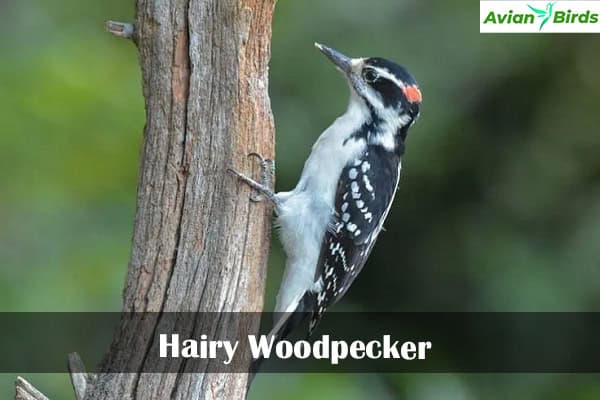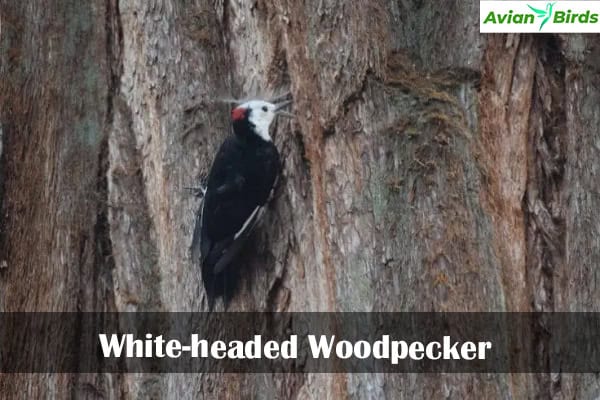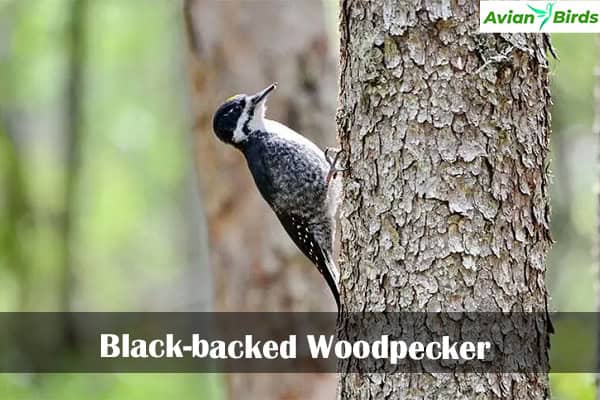8 Types of Woodpeckers in Washington (With Pictures)
Exploring Washington State, I’m captivated by the woodpeckers in Washington and over 500 bird species. From the rugged coastlines to the lush forests, each habitat is a birder’s paradise. Near Seattle, Discovery Park beckons, while the Skagit Wildlife Area offers northern treasures. The Dungeness Refuge and Olympic National Park are northwest gems. Central spots like Mount Rainier and the Turnbull Refuge in the east promise unique sightings. It’s a journey through nature’s symphony, where woodpeckers’ rhythmic drumming is a highlight.
1. Downy Woodpecker
- Scientific name – Dryobates pubescens
- Lifespan – 11 years (maximum recorded)
- Size – (14 to 17 cm)
- Weight – (21 to 28 g)
- Wingspan – (25 to 30 cm)
- Status – Least concern
The Downy Woodpecker is a small woodpecker in North America. They’re mostly black and white with a red patch on the males’ necks. They make loud sounds like whinnies and “pik” notes.

These woodpeckers in Washington find homes in fence posts, dead trees, or parts of live trees that aren’t alive anymore. They dig holes under stubs to make nests, making a new one each year. Female woodpeckers lay about three to eight eggs at a time. It takes about 12 days for the eggs to hatch, and then the baby birds stay in the nest for 18 to 21 days before they can fly.
2. Hairy Woodpecker
- Scientific name – Dryobates villosus
- Lifespan –15 years (maximum recorded)
- Size – (18 to 26 cm)
- Weight – (40 to 95 g)
- Wingspan – (33 to 41 cm)
- Status – Least concern
The Hairy Woodpecker is about the same size as the Downy Woodpecker and looks quite similar too. They have white bellies, black and white striped heads, black backs with white spots on their wings, and a white back.

Male Hairy Woodpeckers have a red patch on their necks that females don’t have. One way to tell them apart from Downy Woodpeckers is by their plain white tail feathers.
These woodpeckers make short “peek” calls and longer whinnying sounds.
For homes, they dig holes in dead parts of live trees, usually in a dead stub or a dead tree. They make a new hole each breeding season. Females lay about three to six eggs at a time. It takes 11 to 12 days for the eggs to hatch, and then the baby birds stay in the nest for 28 to 30 days before they can fly.
3. Pileated Woodpecker
- Scientific name – Dryocopus pileatus
- Lifespan – 12 years (maximum recorded)
- Size – (40 to 49 cm)
- Weight – (250 to 350 g)
- Wingspan – (66 to 75 cm)
- Status – Least concern
The Pileated Woodpecker is the biggest woodpecker you’ll find in Washington State. It’s mostly black with white stripes on its head and neck, a red crest, and white under its wings. Look for small white crescents near its upper wing feathers.

You can tell males and females apart by their faces. Males have red on their foreheads and cheeks, while females have black there.
Pileated Woodpeckers are noisy birds, often making long piping sounds, as well as “wuk-wuk” or “cuk-cuk” calls.
They make their homes by digging holes in dead trees, whether they’re deciduous or coniferous. Each breeding season, they make a new hole. Females lay three to five eggs at a time. It takes about 15 to 18 days for the eggs to hatch, and then the baby birds stay in the nest for 24 to 31 days before they can fly.
4. White-headed Woodpecker
- Scientific name – Dryobates albolarvatus
- Lifespan – 4 years (maximum recorded)
- Size – (21 to 23 cm)
- Weight – (55 to 65 g)
- Wingspan – 16.9 in (43 cm)
- Status – Least concern
The White-headed Woodpecker is a unique-looking bird in North America. It’s medium-sized with a white head and a black body. When it flies, you can see white patches on its wings. Males also have a red patch at the back of their heads, which females don’t have.

They make a sharp, fast sound like “pee-kik” or “pee-kik-kik”.
These woodpeckers in Washington build their homes in holes in dead pine or fir trees, or in parts of live trees that aren’t alive anymore. They usually make a new hole each year instead of reusing old ones. When they lay eggs, there can be anywhere from two to nine in a bunch. It takes about 14 days for the eggs to hatch, and then the baby birds stay in the nest for 26 days.
They mostly eat pine seeds, especially the big ones. Sometimes they also drink sap from trees or eat insects like cicadas, beetles, ants, and termites.
Luckily, the White-headed Woodpecker is doing pretty well in terms of numbers. Their population has been increasing by about 1.1% each year since 1968, and there are estimated to be around 240,000 of them.
5. Lewis’s Woodpecker
- Scientific name – Melanerpes lewis
- Lifespan – 10 years
- Size – 10.2 to 11 in
- Weight – 3.1 to 4.9 oz
- Wingspan – 19.3 to 20.5 in
- Status – Least concern
Lewis’s Woodpecker is a pretty big bird with some interesting colors. They have dark green on top and reddish pink underneath. Their face is red, and they have a grey collar around their neck.

These woodpeckers aren’t very loud. They mostly make a series of loud “churr” sounds.
Instead of making their nests, they use old holes made by other woodpeckers or gaps in dead or dying trees. They hardly ever nest in live trees. They tend to use the same nest hole for many years. Females lay five to nine eggs at once. It takes about 12 to 16 days for the eggs to hatch, and then the baby birds stay in the nest for 28 to 34 days.
They eat nuts, fruits, and insects.
Unfortunately, Lewis’s Woodpecker is at risk of becoming extinct if we don’t take action to help them. Their population has gone down by about 48% in the last 50 years. There are estimated to be about 82,000 of them left. One big threat to them is things like logging, stopping fires, and too many animals eating the grass.
6. Black-backed Woodpecker
- Scientific name – Picoides arcticus
- Lifespan – 8 years
- Size (average) – 9.1 in
- Weight – 2.1 to 3.1 oz
- Wingspan – 15.8 to 16.5 in
- Status – Least concern
The Black-backed Woodpecker is a medium-sized bird with dark feathers. It looks a lot like the American Three-toed Woodpecker and has three toes. Their upperparts are black with white spots on their wings, and their heads are black with a single white stripe below their eye.

Their bellies are white, their sides have stripes, and the feathers on the outer part of their tails are white. You can tell males apart from females because males have a yellow spot on the top of their heads, while females have a black spot there.
They make high-pitched, sharp sounds like “kyik” and “pik”.
When it comes to making homes, they usually pick small dead trees in places where there are lots of big trees around. They hardly ever use dead parts of live trees. Every time they need to lay eggs, they make a new hole for their nest. Each female lays about two to six eggs at once. It takes about 12 to 14 days for the eggs to hatch, and then the baby birds stay in the nest for another 22 to 26 days.
Their favorite food is big beetle larvae that burrow into wood, but they also eat other types of beetle larvae.
7. American Three-toed Woodpecker
- Scientific name – Picoides dorsalis
- Lifespan – 6 years
- Size – 8.3 to 9.1 in
- Weight – 1.6 to 2.4 oz
- Wingspan – 14.6 to 15.3 in
- Status – Least concern
The American Three-toed Woodpecker is named for its unique feature of having only three toes, which is rare among North American woodpeckers in Washington. This small bird has mostly black feathers on its upper parts with a barred back that is black and white, white spots on its wings, and stripes on its sides.

Their bellies are whitish, their outer tail feathers are white with black bars, and their heads are mostly black with two white stripes. Male birds have a yellow spot on the top of their heads.
These woodpeckers make two main sounds: a nasal “klimp” and a sharp “pik”.
They usually make their homes in dead coniferous trees or parts of live trees by digging holes. They make a new hole each year. The number of eggs in each bunch can be anywhere from three to seven. It takes about 12 to 14 days for the eggs to hatch, and then the baby birds stay in the nest for 22 to 26 days.
8. Northern Flicker
- Scientific name – Colaptes auratus
- Lifespan –9 years (maximum recorded)
- Size – (28 to 31 cm)
- Weight – (110 to 160 g)
- Wingspan – (42 to 51 cm)
- Status – Least concern
The Northern Flicker is a big woodpecker with a distinctive pattern. Its name comes from the colors on its wings and tail that look like flickering flames when it flies. In Washington State, you’ll mostly see the red-shafted subspecies.

They have buff-colored bellies with black spots, grey-brown feathers on top with black stripes, a white patch on their backsides, and a black spot on their throats. Their faces are grey with a red stripe on the side of their heads. When they fly, you can see their red feathers under their wings and tails. The females don’t have the red stripe on their faces like the males do.
Northern Flickers usually make their homes by digging holes in dead or injured trees. Sometimes, they even nest in holes in the sides of banks. They often use the same nest from year to year. When they lay eggs, females usually lay about five to eight at a time. It takes about 11 to 13 days for the eggs to hatch, and then the baby birds leave the nest after about 24 to 27 days.
They make a distinctive rolling rattle sound, along with a single “kyeer” call.
Check Our Previous Articles:
Wrapping up…
In the end, Woodpeckers in Washington State offers a fantastic opportunity for woodpecker enthusiasts due to its diverse range of woodpecker species. Since the state sits in a location where many woodpeckers from northern areas can be found, it serves as a haven for these birds. If you’re keen on spotting woodpeckers, one effective method is to listen to their distinctive drumming sounds.
Unfortunately, woodpeckers face significant conservation challenges, primarily due to forestry practices such as logging. These activities disrupt and destroy crucial woodpecker habitats by reducing the number of trees, both dead and alive, that serve as nesting and foraging sites.
Frequently Asked Questions:
Q1. What are the types of woodpeckers in Washington state?
Various woodpecker species inhabit Washington state, including the Downy Woodpecker, Hairy Woodpecker, Pileated Woodpecker, and Northern Flicker.
Q2. What kind of woodpeckers are in DC?
In Washington, DC, you can find woodpecker species such as the Downy Woodpecker, Hairy Woodpecker, and Northern Flicker.
Q3. Which is the most common woodpecker?
The Downy Woodpecker is one of the most common woodpecker species found across North America, including Washington state and Washington, DC.
Q4. Is it rare to see woodpeckers in Washington?
Woodpeckers are not extremely rare birds, and depending on your location and habitat, you may encounter them regularly, especially in wooded areas. However, spotting specific species can vary depending on factors like habitat availability and regional distribution.







